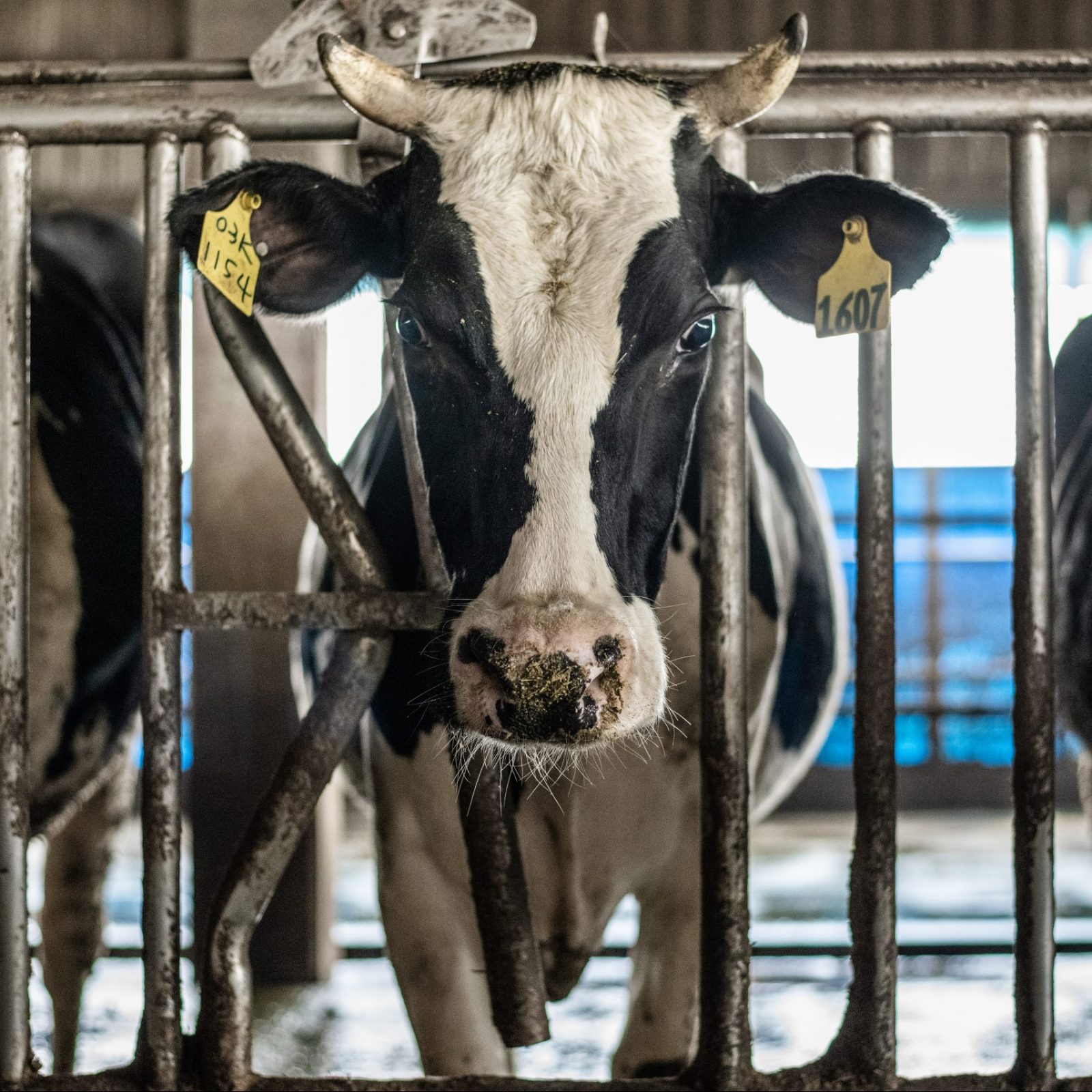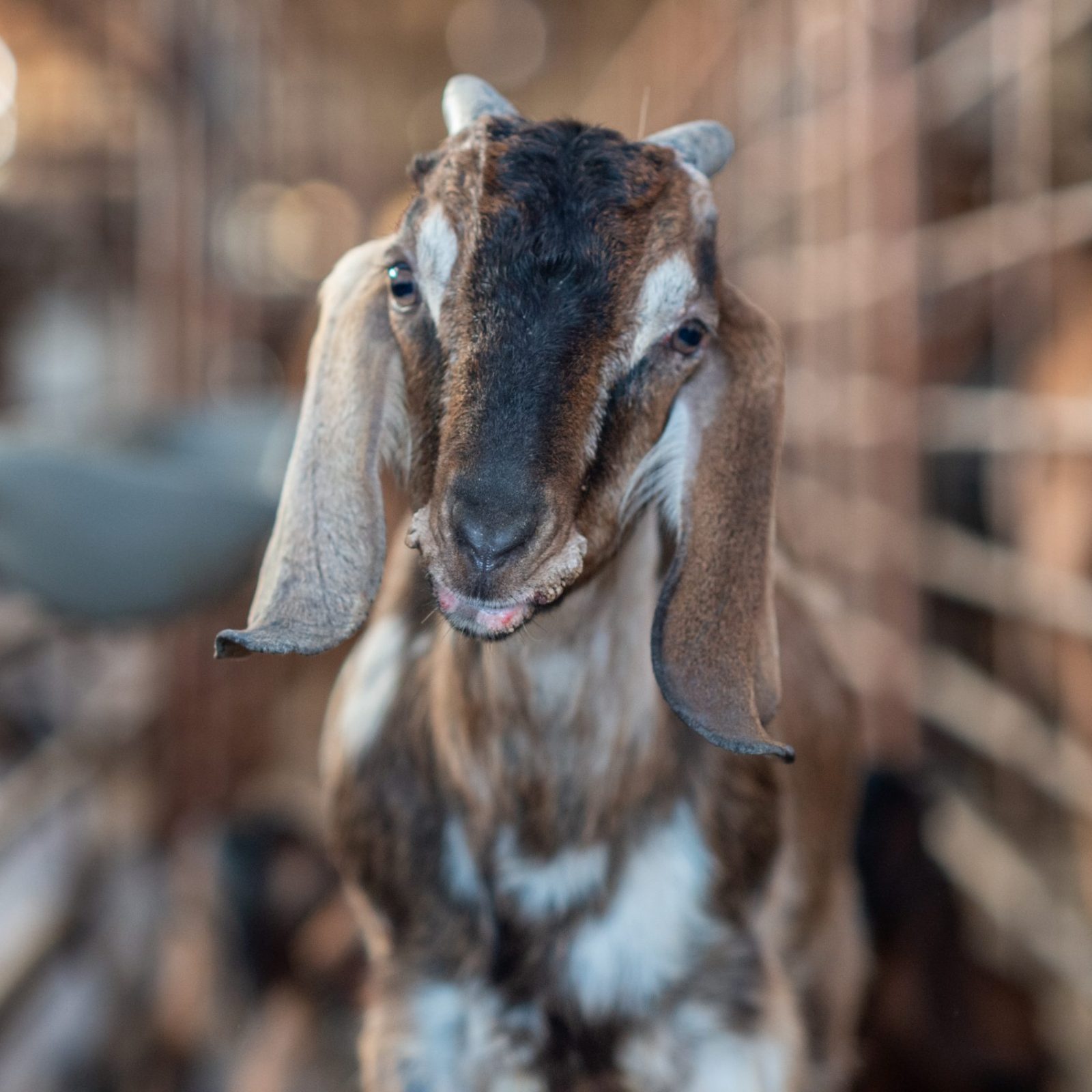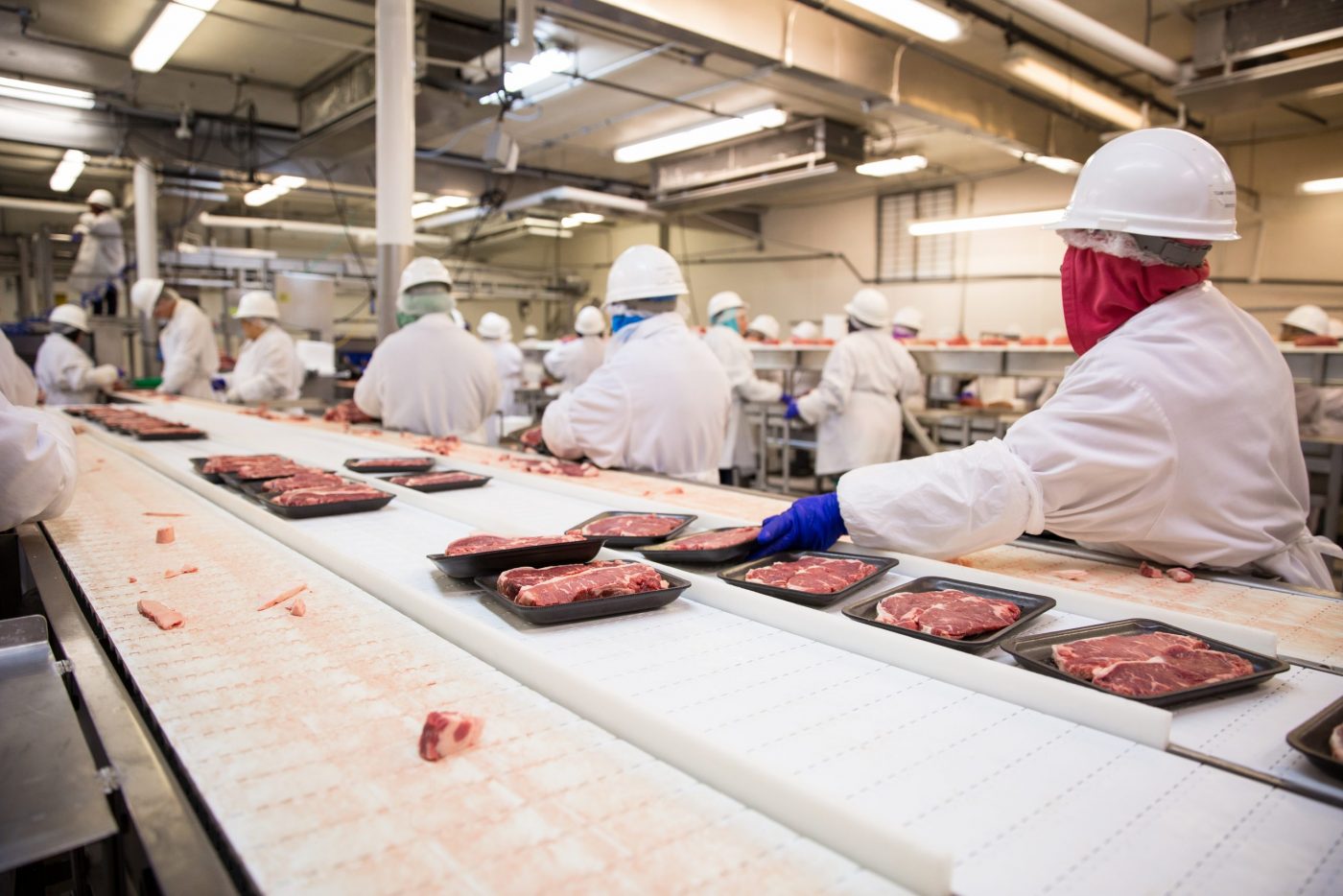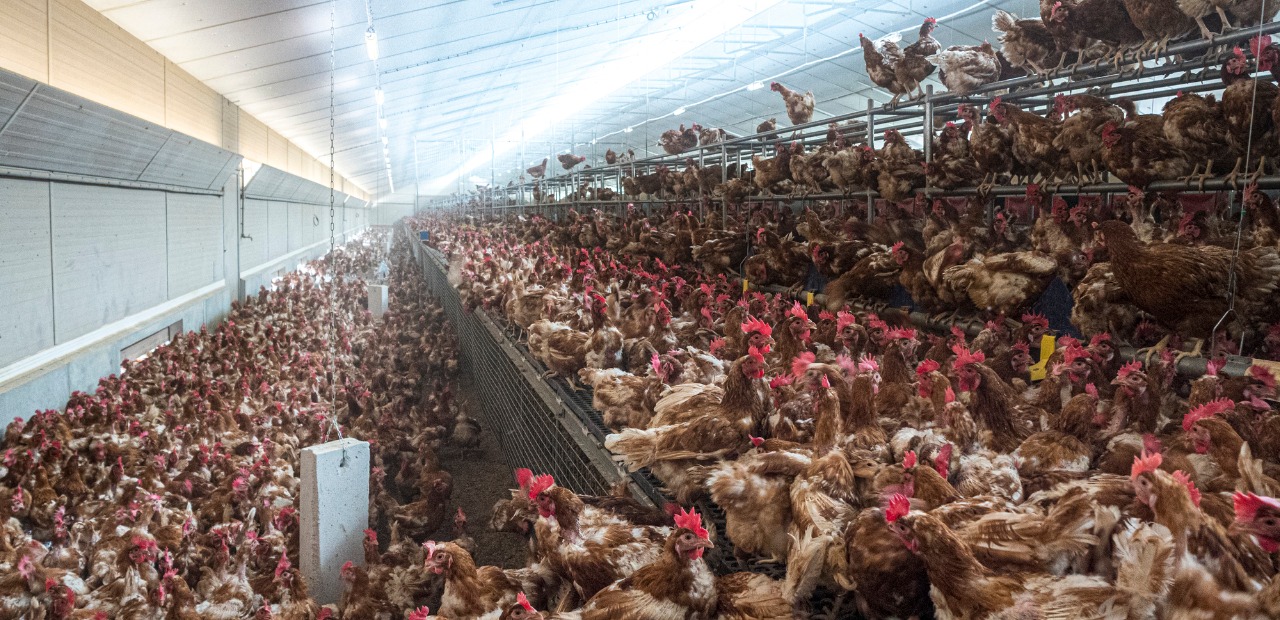A Brief History of Factory Farming
9,000 to 8,000 BCE
Hunting and gathering was Homo sapiens’ food system for almost 90 percent of human history. Following the last ice age, a changing climate offered favorable conditions for the dawn of agriculture, and humans in the Fertile Crescent of the Middle East began domesticating wild animals – ancestors of domestic sheep, goats, cows, and pigs. In the following millenia, agriculture spread and independently arose across the world, leading to a shift from hunter-gatherer to agrarian societies.
1492
Following Christopher Columbus’ first voyage to the Americas in 1492, European colonists brought people they enslaved to the New World, as well as diseases and animals, in what is known as the Columbian Exchange. The initial eight pigs, twenty-five horses, and other animal species brought by Columbus and subsequent voyages became populations of millions of new animals in the Americas in a matter of decades.
16th century
Colonial society in the Americas became economically dependent on a livestock-based farming model, in contrast to indigenous people’s traditional relationship to food, being far less centered on domesticated animals. This livestock-based farming model required extensive use of land and was a driving force in further colonization and expansion.
17th century
The middle of the 17th century in Britain saw the start of a progression of discoveries and innovations known as the British Agricultural Revolution. Among these changes was the widespread adoption of a more intensive crop rotation system, which in turn increased productivity and made it feasible to feed and produce larger numbers of animals.
18th to 19th centuries
The Industrial Revolution – a period which emphasized increasing profit and productivity – saw the innovation of technologies for mass production and set the stage for the future industrialization of animal agriculture. Agriculturalists Robert Bakewell and Thomas Coke developed selective breeding of animals in agriculture, creating sheep who grow unnaturally long wool and cows who grow unnaturally large.
1906
After seven weeks going undercover at meat processing plants in Chicago, Illinois, author Upton Sinclair published The Jungle to expose the dangerous working conditions for laborers and cruelty towards animals in the industry. Instead, the public became infuriated over the details surrounding food quality, as his work also pointed out the extremely unsanitary practices involved. As put by Sinclair, “I aimed at the public’s heart and by accident I hit it in the stomach.”
1930
Public outcry about food safety in 1906 had led to the passage of the Federal Meat Inspection Act and Pure Food and Drug Act, which mandated inspection of food products and animals used for food but did not address labor conditions nor animal welfare. The Meat Inspection Act was assigned to the Food Safety and Inspection Service under the USDA. The Pure Food and Drug Act was assigned to the Bureau of Chemistry, which was renamed the FDA in 1930.
1930s to 1940s
The discovery of antibiotics in the early 20th century made its way to application in the agriculture sector in the U.S., first being marketed for use in animals in 1938. The ability to drastically reduce the spread of disease in farmed animals led to higher productivity and even greater intensification in animal agriculture.
1930s to 1960s
The U.S. government began to strongly endorse industrialized farming as a means of production. As new technologies continued to intensify agriculture, legislation granting federal monetary support aided this growing level of production. The first of these bills was the 1933 Agricultural Adjustment Act, a price-support program designed to sustain agricultural production post-WWI and during the Great Depression.
1980s
Toward the end of the 20th century, the general structure of industrialized agriculture we see today was established and the relationship of our food system to animals, rural communities, consumers, and agricultural workers had radically changed.
1986
After documenting abusive practices of the animal agriculture industry through undercover investigations, Farm Sanctuary was founded in 1986 as a national nonprofit dedicated to exposing and challenging these practices and working to change the way society views and treats farmed animals.
1990s
From 1950 to 1997, U.S. farms on average doubled in size and the number of farms was halved. Animal agriculture shifted from many small farms with few animals, to fewer and larger farms with thousands of animals. Agricultural labor went from employing 47% of the U.S. population to 2%.
2009
The 2009 swine flu (H1N1) pandemic made its way across the world, killing an estimated 150,000-575,000 people. An earlier strain of the virus had been identified in U.S. factory farms in the 1990s and circulated throughout pig farms over the following decade before making the jump to humans. A combination of high-density animal confinement and poor regulation likely fostered an environment conducive to the spread of the virus.
2010s
Factory farming in the U.S. represented 99% of animal agriculture. By the end of the decade, the annual number of animals slaughtered neared 10 billion. Agricultural subsidies became disproportionately allocated to commodity crops. Corn and soy production alone, grown predominantly as feed for farmed animals, received over 45% of U.S. agricultural subsidies. Less than 1% of U.S. agricultural subsidies went toward the production of non-commodity crop vegetables and fruits.
2020
A broad-based movement of anti-factory farming advocacy organizations, representing the interests of workers, rural communities, animals, the environment, and public health, have mobilized to shine a light on the dark realities of industrialized farming and advocate for legal and structural change, including models for a community-centered, plant-based food system and an end to all animal agriculture.

Image: Everett Collection/shutterstock.com
9,000 to 8,000 BCE
Hunting and gathering was Homo sapiens’ food system for almost 90 percent of human history. Following the last ice age, a changing climate offered favorable conditions for the dawn of agriculture, and humans in the Fertile Crescent of the Middle East began domesticating wild animals – ancestors of domestic sheep, goats, cows, and pigs. In the following millenia, agriculture spread and independently arose across the world, leading to a shift from hunter-gatherer to agrarian societies.

Image: Everett Collection/shutterstock.com
1492
Following Christopher Columbus’ first voyage to the Americas in 1492, European colonists brought people they enslaved to the New World, as well as diseases and animals, in what is known as the Columbian Exchange. The initial eight pigs, twenty-five horses, and other animal species brought by Columbus and subsequent voyages became populations of millions of new animals in the Americas in a matter of decades.

Image: North Wind Picture Archives / Alamy Stock Photo
16th century
Colonial society in the Americas became economically dependent on a livestock-based farming model, in contrast to indigenous people’s traditional relationship to food, being far less centered on domesticated animals. This livestock-based farming model required extensive use of land and was a driving force in further colonization and expansion.

Image: John Slezer / Public domain
17th century
The middle of the 17th century in Britain saw the start of a progression of discoveries and innovations known as the British Agricultural Revolution. Among these changes was the widespread adoption of a more intensive crop rotation system, which in turn increased productivity and made it feasible to feed and produce larger numbers of animals.

Image: John Boultbee / Public domain
18th to 19th centuries
The Industrial Revolution – a period which emphasized increasing profit and productivity – saw the innovation of technologies for mass production and set the stage for the future industrialization of animal agriculture. Agriculturalists Robert Bakewell and Thomas Coke developed selective breeding of animals in agriculture, creating sheep who grow unnaturally long wool and cows who grow unnaturally large.

Photo: John Vachon / Public domain
1906
After seven weeks going undercover at meat processing plants in Chicago, Illinois, author Upton Sinclair published The Jungle to expose the dangerous working conditions for laborers and cruelty towards animals in the industry. Instead, the public became infuriated over the details surrounding food quality, as his work also pointed out the extremely unsanitary practices involved. As put by Sinclair, “I aimed at the public’s heart and by accident I hit it in the stomach.”

Photo: National Archives, Records of the Bureau of Animal Industry / Public domain
1930
Public outcry about food safety in 1906 had led to the passage of the Federal Meat Inspection Act and Pure Food and Drug Act, which mandated inspection of food products and animals used for food but did not address labor conditions nor animal welfare. The Meat Inspection Act was assigned to the Food Safety and Inspection Service under the USDA. The Pure Food and Drug Act was assigned to the Bureau of Chemistry, which was renamed the FDA in 1930.

Image: © IWM Art.IWM ART LD 4217
1930s to 1940s
The discovery of antibiotics in the early 20th century made its way to application in the agriculture sector in the U.S., first being marketed for use in animals in 1938. The ability to drastically reduce the spread of disease in farmed animals led to higher productivity and even greater intensification in animal agriculture.

Photo: National Archives at College Park / Public domain
1930s to 1960s
The U.S. government began to strongly endorse industrialized farming as a means of production. As new technologies continued to intensify agriculture, legislation granting federal monetary support aided this growing level of production. The first of these bills was the 1933 Agricultural Adjustment Act, a price-support program designed to sustain agricultural production post-WWI and during the Great Depression.

Photo: By Natchapon Srihon/Shutterstock
1980s
Toward the end of the 20th century, the general structure of industrialized agriculture we see today was established and the relationship of our food system to animals, rural communities, consumers, and agricultural workers had radically changed.

Photo: Farm Sanctuary
1986
After documenting abusive practices of the animal agriculture industry through undercover investigations, Farm Sanctuary was founded in 1986 as a national nonprofit dedicated to exposing and challenging these practices and working to change the way society views and treats farmed animals.

Photo: Jo-Anne McArthur
1990s
From 1950 to 1997, U.S. farms on average doubled in size and the number of farms was halved. Animal agriculture shifted from many small farms with few animals, to fewer and larger farms with thousands of animals. Agricultural labor went from employing 47% of the U.S. population to 2%.

Photo: Iakov Filimonov/Shutterstock
2009
The 2009 swine flu (H1N1) pandemic made its way across the world, killing an estimated 150,000-575,000 people. An earlier strain of the virus had been identified in U.S. factory farms in the 1990s and circulated throughout pig farms over the following decade before making the jump to humans. A combination of high-density animal confinement and poor regulation likely fostered an environment conducive to the spread of the virus.

Photo: Farm Sanctuary
2010s
Factory farming in the U.S. represented 99% of animal agriculture. By the end of the decade, the annual number of animals slaughtered neared 10 billion. Agricultural subsidies became disproportionately allocated to commodity crops. Corn and soy production alone, grown predominantly as feed for farmed animals, received over 45% of U.S. agricultural subsidies. Less than 1% of U.S. agricultural subsidies went toward the production of non-commodity crop vegetables and fruits.

Photo: Farm Sanctuary
2020
A broad-based movement of anti-factory farming advocacy organizations, representing the interests of workers, rural communities, animals, the environment, and public health, have mobilized to shine a light on the dark realities of industrialized farming and advocate for legal and structural change, including models for a community-centered, plant-based food system and an end to all animal agriculture.
A Look Inside Today's Factory Farms

Photo: Jo-Anne McArthur / Animal Equality
Chickens used for egg production are among the most widely abused of all farm animals. In 2018, to meet the American demand for eggs, over 330 million hens were kept and expected to lay nearly 95 billion eggs. From hatching to slaughter, egg-laying hens are subjected to mutilation, confinement, and abuse, and are deprived of the ability to live their lives as active, social animals.

Photo: Jo-Anne McArthur / We Animals
Every year, over 9 billion chickens are slaughtered for meat in the U.S., making chickens the most commonly killed domestic animal—95% of commercially slaughtered animals in America are chickens. Called “broilers” by the industry, these curious, social birds are treated simply as production units, selectively bred and fed for abnormally fast growth without consideration for their well-being.

Photo: Jo-Anne McArthur / Essere Animali
In an average week more than 2 million pigs are slaughtered in the U.S., almost exclusively to be processed and eaten by people as “pork” products—primarily bacon, ham, and sausage. In 2017, about 135 million pigs were sold in the U.S., and 95% of those were raised on “farms” with 5,000 or more individual pigs.

Photo: Jo-Anne McArthur / We Animals
Cows used by the dairy industry are intensively confined, continually impregnated, and bred for high milk production with little concern for their well-being. In 2017, more than 9.3 million cows were used to produce milk in the United States. In the same year, more than 3 million dairy cows were slaughtered for meat.

Photo: Jo-Anne McArthur / Israel Against Live Shipments
In 2019, 33 million cattle were slaughtered for beef in the United States. Young calves are nearly always separated from their nurturing mothers and often endure a series of painful mutilations including branding, dehorning, and castration. Within their first year, they endure the long, stressful journey to a feedlot, where they will be fattened on an unnatural diet and then sent to slaughter.

Photo: Jo-Anne McArthur / Djurrattsalliansen
Turkeys raised for human consumption are crowded into poorly ventilated industrial production facilities, sometimes with as many as 10,000 birds packed into a single factory building. In 2017, 285 million of these naturally explorative and socially sophisticated birds were slaughtered in the United States, doubling the number killed for food just 40 years earlier.

Photo: Jo-Anne McArthur / We Animals
In the U.S., sheep are raised for meat, for milk, and for fibers used in textiles. In all three industries, these playful, intelligent animals routinely suffer inhumane treatment throughout their lives and are ultimately slaughtered for human consumption. Over two million sheep are slaughtered for meat every year in the United States.

Photo: Jo-Anne McArthur / We Animals
Goats are also raised for meat, milk, and fibers. More than 620,000 goats were slaughtered for meat in the U.S. in 2018—usually at just 3-5 months old, a fraction of their natural lifespan. Like dairy cows, goats used for dairy are kept continually impregnated through artificial insemination so that they keep producing milk.
Facts
-

Photo: Jo-Anne McArthur / We Animals
-
9 billion+
chickens are slaughtered for food each year in the United States.
-
Animal agriculture is responsible for 14.5% of anthropogenic greenhouse gas emissions worldwide.
-
Many slaughterhouses experience a very high rate of labor turnover, sometimes greater than 100% in a year.
-
The CDC warns that 3 out of every 4 new or emerging infectious diseases in people come from animals.
Photo: Jo-Anne McArthur / We Animals

Photo: Jo-Anne McArthur / We Animals
The Animals in Animal Agriculture
Turkey photo: Jo-Anne McArthur / Djurrattsalliansen
All other photos: Jo-Anne McArthur / We Animals



Chickens
Learn More


Cows
Learn More


Goats
Learn More


Sheep
Learn More


Turkeys
Learn More


Pigs
Learn MoreTurkey photo: Jo-Anne McArthur / Djurrattsalliansen
All other photos: Jo-Anne McArthur / We Animals
learn more




















